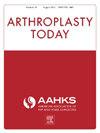Effects of Malnutrition on Perioperative Outcomes of Total Hip Arthroplasty: A Systematic Review and Meta-Analysis
IF 2.1
Q3 ORTHOPEDICS
引用次数: 0
Abstract
Background
Malnutrition can play a significant role in wound healing, immune response, and conditioning. The purpose of this review is to characterize definitions of malnutrition in total hip arthroplasty (THA) and analyze its effects on postoperative outcomes.
Methods
A systematic search was conducted using iterations of the key terms “total hip arthroplasty” and “malnutrition.” Human studies describing malnutrition in patients undergoing primary THA for either traumatic or elective indications were included. Using the SPSS meta-analysis binary and continuous model function, the mean effect size estimate (MSE) or Cohen’s d (Cd) statistic with 95% confidence interval was reported.
Results
This search yielded a total of 555 studies, of which 9 articles comprising 495,657 patients undergoing primary THA were included, characterizing 16,895 patients (3.4%) as malnourished. Studies characterized malnutrition as albumin <3.5 g/dL (n = 7) and total lymphocyte count <1500 (n = 1). Malnutrition was associated with an increased rate of nonhome discharge (MSE = 0.81, [0.55-1.07]) and likelihood of readmission (MSE = 0.86, [0.75-0.97]). Malnutrition at the time of surgery was also associated with increased rates of any complication (MSE = 1.01, [0.46-1.57]), wound complications (MSE = 1.04, [0.72-1.36]), pulmonary complications (MSE = 1.54, [1.29-1.78]), need for transfusion (MSE = 0.75, [0.54-0.96]), periprosthetic fracture (MSE = 0.65, [0.47-0.82]), reoperation (MSE = 0.72, [0.58-0.86]), and perioperative mortality (MSE = 2.05, [1.76-2.33]).
Conclusions
Malnutrition was found to have significant associations with complications and disposition following THA. The findings from this meta-analysis provide support for further investigation into perioperative nutritional supplementation strategies for surgeons to optimize at-risk patients prior to THA.
Level of Evidence
III.
营养不良对全髋关节置换术围手术期疗效的影响:一项系统回顾和荟萃分析
营养不良在伤口愈合、免疫反应和调节中起着重要作用。本综述的目的是描述全髋关节置换术(THA)中营养不良的定义,并分析其对术后结果的影响。方法对关键词“全髋关节置换术”和“营养不良”进行系统检索。人类研究描述了因创伤性或选择性适应症接受原发性THA的患者营养不良。采用SPSS元分析二元和连续模型函数,报告95%置信区间的平均效应大小估计(MSE)或Cohen’s d (Cd)统计量。结果本次检索共纳入555项研究,其中9篇文章纳入495,657例原发性THA患者,其中16,895例(3.4%)为营养不良。研究将营养不良定性为白蛋白3.5 g/dL (n = 7)和总淋巴细胞计数1500 (n = 1)。营养不良与非家庭出院率(MSE = 0.81,[0.55-1.07])和再入院可能性(MSE = 0.86,[0.75-0.97])的增加有关。手术时的营养不良还与各种并发症(MSE = 1.01,[0.46-1.57])、伤口并发症(MSE = 1.04,[0.72-1.36])、肺部并发症(MSE = 1.54,[1.29-1.78])、需要输血(MSE = 0.75,[0.54-0.96])、假体周围骨折(MSE = 0.65,[0.47-0.82])、再手术(MSE = 0.72,[0.58-0.86])和围手术期死亡率(MSE = 2.05,[1.76-2.33])的发生率增加有关。结论营养不良与全髋关节置换术后并发症及预后有显著关系。这项荟萃分析的结果为进一步研究外科医生优化THA前高危患者围手术期营养补充策略提供了支持。证据水平ⅱ。
本文章由计算机程序翻译,如有差异,请以英文原文为准。
求助全文
约1分钟内获得全文
求助全文
来源期刊

Arthroplasty Today
Medicine-Surgery
CiteScore
2.90
自引率
0.00%
发文量
258
审稿时长
40 weeks
期刊介绍:
Arthroplasty Today is a companion journal to the Journal of Arthroplasty. The journal Arthroplasty Today brings together the clinical and scientific foundations for joint replacement of the hip and knee in an open-access, online format. Arthroplasty Today solicits manuscripts of the highest quality from all areas of scientific endeavor that relate to joint replacement or the treatment of its complications, including those dealing with patient outcomes, economic and policy issues, prosthetic design, biomechanics, biomaterials, and biologic response to arthroplasty. The journal focuses on case reports. It is the purpose of Arthroplasty Today to present material to practicing orthopaedic surgeons that will keep them abreast of developments in the field, prove useful in the care of patients, and aid in understanding the scientific foundation of this subspecialty area of joint replacement. The international members of the Editorial Board provide a worldwide perspective for the journal''s area of interest. Their participation ensures that each issue of Arthroplasty Today provides the reader with timely, peer-reviewed articles of the highest quality.
 求助内容:
求助内容: 应助结果提醒方式:
应助结果提醒方式:


